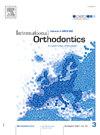Effect of varying thicknesses and temperature changes on shape memory behaviour in 3D DPA versus thermoformed clear aligner materials: An in vitro study
IF 1.9
Q2 DENTISTRY, ORAL SURGERY & MEDICINE
引用次数: 0
Abstract
Background
The present study evaluated the shape memory behaviour of TA-28 compared to PET-G at different thicknesses and temperatures.
Methods
Two materials were tested: thermoformed CA Pro (PET-G) and 3D-printed TA-28 (Graphy, Korea), in 0.5 mm and 0.75 mm thicknesses. A total of 160 aligner strips were fabricated and tested for shape recovery at 30 °C, 37 °C, 40 °C, and 80 °C. Each strip was bent at 100 °C and recovery was measured over 60 minutes using a protractor-based template.
Results
TA-28 exhibited significantly higher shape recovery than PET-G at all temperatures (P ≤ 0.001). Recovery increased with temperature and was greatest for the 0.5 mm TA-28 samples. At 37 °C, TA-28 reached up to 60.7% recovery within 60 minutes, while PET-G showed negligible change. Three-way ANOVA revealed significant interactions among material, thickness, and temperature (P = 0.005).
Conclusion
TA-28 aligners demonstrate superior shape memory properties compared to PET-G, particularly at body temperature. TA-28 samples with 0.5 mm thickness recovered faster and to a greater extent, offering more consistent force delivery.
Clinical significance
Directly 3D-printed TA-28 aligners may enhance treatment predictability, reduce patient discomfort, and provide sustained orthodontic force due to their temperature-responsive shape recovery. These findings support the use of smart materials in future orthodontic aligner design.
不同厚度和温度变化对3D DPA与热成型透明对准材料形状记忆行为的影响:一项体外研究
本研究评估了TA-28与PET-G在不同厚度和温度下的形状记忆行为。方法测试两种材料:热成型CA Pro (PET-G)和3d打印TA-28(韩国,Graphy),厚度分别为0.5 mm和0.75 mm。共制作了160个对准器条带,并在30°C, 37°C, 40°C和80°C下测试了形状恢复。每个条带在100°C下弯曲,使用量角器为基础的模板在60分钟内测量恢复。结果在不同温度下,sta -28的形状恢复明显高于PET-G (P≤0.001)。回收率随温度升高而增加,其中0.5 mm TA-28样品的回收率最高。37℃时,TA-28在60分钟内的回收率高达60.7%,而PET-G的变化可以忽略不计。三因素方差分析显示,材料、厚度和温度之间存在显著的相互作用(P = 0.005)。结论与PET-G相比,ta -28矫正剂具有更好的形状记忆性能,特别是在体温下。0.5 mm厚度的TA-28样品恢复得更快,在更大程度上,提供更一致的力传递。直接3d打印TA-28矫正器可以提高治疗的可预测性,减少患者的不适,并且由于其温度响应形状恢复而提供持续的正畸力。这些发现支持了智能材料在未来正畸矫正器设计中的应用。
本文章由计算机程序翻译,如有差异,请以英文原文为准。
求助全文
约1分钟内获得全文
求助全文
来源期刊

International Orthodontics
DENTISTRY, ORAL SURGERY & MEDICINE-
CiteScore
2.50
自引率
13.30%
发文量
71
审稿时长
26 days
期刊介绍:
Une revue de référence dans le domaine de orthodontie et des disciplines frontières Your reference in dentofacial orthopedics International Orthodontics adresse aux orthodontistes, aux dentistes, aux stomatologistes, aux chirurgiens maxillo-faciaux et aux plasticiens de la face, ainsi quà leurs assistant(e)s. International Orthodontics is addressed to orthodontists, dentists, stomatologists, maxillofacial surgeons and facial plastic surgeons, as well as their assistants.
 求助内容:
求助内容: 应助结果提醒方式:
应助结果提醒方式:


